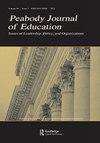Dual Language Bilingual Education as a Pathway to Racial Integration? A Place-Based Analysis of Policy Enactment
Q2 Social Sciences
引用次数: 0
Abstract
ABSTRACT Across the United States, cities like St. Louis may be perceived as predominantly Black/White and monolingual. In such places, there are often few state resources and expertise driving the new growth of dual language bilingual education (DLBE)—that is, policies and programs that aim to develop students’ bilingualism and biculturalism from an early age. Moreover, research rarely explores how DLBE programs develop within particular racial and political contexts, despite their goals to integrate diverse youth. This study focuses on the city of St. Louis to examine how DLBE policies are enacted within particular localities, especially for children from racially and linguistically minoritized backgrounds. Framed by theories of policy enactment, this analysis is part of three multiyear partnerships focused on language education in St. Louis and two school districts in similar state contexts. We found that DLBE enactment in each school system was shaped by community histories, changing demographics, and local education policies focused on racial desegregation and school choice. While each space created racially integrated schools, their enactment was shrouded by Whiteness, especially the history of magnet schools and (White) parental choice as essential for schools’ development. We conclude that place-based research and communal partnerships must carefully consider the unique factors shaping education reform, to recognize for and by whom new programs are truly created and to work toward more socially just, transformative educational contexts.双语教育是实现种族融合的途径吗?基于地方的政策制定分析
在美国,像圣路易斯这样的城市可能被认为主要是黑人/白人和单语。在这些地方,通常很少有国家资源和专业知识来推动双语双语教育(DLBE)的新发展,即旨在从小培养学生的双语能力和双文化能力的政策和项目。此外,研究很少探讨DLBE计划如何在特定的种族和政治背景下发展,尽管他们的目标是整合不同的青年。本研究的重点是圣路易斯市,以检查DLBE政策是如何在特定地区制定的,特别是对于来自种族和语言少数背景的儿童。在政策制定理论的框架下,这一分析是三个多年合作伙伴关系的一部分,重点关注圣路易斯和两个类似州背景下的学区的语言教育。我们发现,每个学校系统中DLBE的制定受到社区历史、不断变化的人口结构和当地教育政策的影响,这些政策侧重于种族隔离和学校选择。虽然每个地方都建立了种族融合的学校,但它们的制定却被白人所笼罩,特别是磁石学校的历史和(白人)家长的选择对学校的发展至关重要。我们的结论是,基于地点的研究和社区伙伴关系必须仔细考虑影响教育改革的独特因素,认识到新项目真正是为谁创建的,由谁创建的,并朝着更社会公正、更具变革意义的教育环境努力。
本文章由计算机程序翻译,如有差异,请以英文原文为准。
求助全文
约1分钟内获得全文
求助全文
来源期刊

Peabody Journal of Education
Social Sciences-Education
CiteScore
2.20
自引率
0.00%
发文量
43
期刊介绍:
Peabody Journal of Education (PJE) publishes quarterly symposia in the broad area of education, including but not limited to topics related to formal institutions serving students in early childhood, pre-school, primary, elementary, intermediate, secondary, post-secondary, and tertiary education. The scope of the journal includes special kinds of educational institutions, such as those providing vocational training or the schooling for students with disabilities. PJE also welcomes manuscript submissions that concentrate on informal education dynamics, those outside the immediate framework of institutions, and education matters that are important to nations outside the United States.
 求助内容:
求助内容: 应助结果提醒方式:
应助结果提醒方式:


